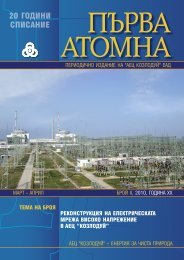Summary Report for Conduct of Kozloduy NPP Stress Tests
Summary Report for Conduct of Kozloduy NPP Stress Tests
Summary Report for Conduct of Kozloduy NPP Stress Tests
You also want an ePaper? Increase the reach of your titles
YUMPU automatically turns print PDFs into web optimized ePapers that Google loves.
“<strong>Kozloduy</strong> <strong>NPP</strong>” PLC<br />
SUMMARY REPORT<br />
<strong>for</strong> <strong>Conduct</strong> <strong>of</strong> <strong>Kozloduy</strong> <strong>NPP</strong><br />
<strong>Stress</strong> <strong>Tests</strong><br />
5.3.3 Loss <strong>of</strong> ultimate heat sink<br />
5.3.3.1 Design bases to remove heat to main ultimate heat sink<br />
Decay heat removal from spent fuel in SFP-3,4 is provided from SFP cooling systems.<br />
Through the heat exchangers <strong>of</strong> these systems, heat is transferred to service water system <strong>for</strong><br />
cooling <strong>of</strong> safety system consumers. After cooling, due to steaming in the spray pools, water is<br />
delivered back to the cold channel.<br />
5.3.3.2 Loss <strong>of</strong> main ultimate heat sink<br />
Alternative way to remove heat from SFP is usage <strong>of</strong> – as the ultimate heat sink – cooling<br />
water from the inlet chamber be<strong>for</strong>e CPS, as supplied by the diesel-pumps, located in FPS-2, to the<br />
heat exchangers <strong>for</strong> SFP cooling.<br />
If it is impossible to remove heat via normal scheme, this may be provided due to steaming<br />
from water surface. To replenish <strong>for</strong> loss due to steaming, two possibilities are envisioned: with<br />
SFP filling pump – from the tank-sump (EMT) or other tanks and with diesel-pumps <strong>of</strong> FPS-2 from<br />
the cold channel.<br />
There are many alternative ways to remove heat from SFP (described in emergency<br />
procedures), which are ensured with independent power supply (electric or with diesel motor) and<br />
with diverse water sources. Due to that at loss <strong>of</strong> main ultimate heat sink, loss <strong>of</strong> safety function<br />
„Heat removal from the spent fuel stored in the reactor building but outside to the reactor” is not<br />
expected.<br />
5.3.3.3 Loss <strong>of</strong> ultimate heat sink and loss <strong>of</strong> alternative heat sink<br />
Times to occurrence <strong>of</strong> main events at complete loss <strong>of</strong> all the possibilities <strong>for</strong> cooling and<br />
filling <strong>of</strong> SFP-3,4 be<strong>for</strong>e uncoverage <strong>of</strong> fuel assemblies stored in the pools are the same, as at<br />
complete loss <strong>of</strong> AC sources.<br />
5.3.3.4 Loss <strong>of</strong> ultimate heat sink, in combination with station blackout (i.e. loss <strong>of</strong> <strong>of</strong>f-site<br />
and emergency power supply at the site)<br />
Times to occurrence <strong>of</strong> the main events are the same, as at complete loss <strong>of</strong> AC sources.<br />
5.3.4 Measures to improve robustness to loss <strong>of</strong> ultimate heat sink<br />
In relation with SFP-3 and SFP-4 no measures are required to enhance robustness to loss <strong>of</strong><br />
ultimate heat sink.<br />
5.4 SPENT FUEL STORAGE (SFS)<br />
157/202

















